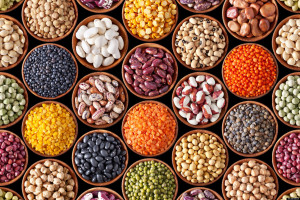 Beans, peas, lentils, and peanuts are collectively known as legumes, which are plants that have pods with tidy rows of seeds inside. The seeds are the fruit of the plants and are removed from the pod then dried for human and animal consumption. Legumes are known as the food of longevity.
Beans, peas, lentils, and peanuts are collectively known as legumes, which are plants that have pods with tidy rows of seeds inside. The seeds are the fruit of the plants and are removed from the pod then dried for human and animal consumption. Legumes are known as the food of longevity.
These tiny little gems pack a lot of nutritional punch. Low in fat, they are an excellent source of protein, fiber, and are rich in antioxidants. They contain iron, zinc, calcium, selenium, and folate and are low glycemic. Best of all they are inexpensive and easy to prepare and can be added to a variety of dishes.
Try adding them to soups, salads, and pasta dishes. Toss beans into sautéed veggies or mix them with cooked greens and garlic.
There are many types to choose from – adzuki beans, black beans, black-eyed peas, broad beans (fava beans), calico beans, cannellini beans, garbanzo beans (also called chickpeas), kidney beans, lentils, lima beans, mung beans, navy beans, peanuts, pinto beans, soybeans (also called edamame) – just to name a few.
Canned beans are super convenient. Drain them in a colander and rinse with water to remove some of the excess salt; or buy canned beans with no salt added. When you have more time, you can make your own by soaking the beans yourself (see below).
The magical fruit…..the more you eat…..the more you ………??!?!
Many people shun beans because of their gaseous aftereffects. Human digestive enzymes can’t break down the fiber and short chains of sugar molecules known as oligosaccharides in beans. But the billions of bacteria living in the gut can digest them, often creating gas in the process. Don’t let that stop you from including these gems to your healthy eating plan.
Here are some tips from the Harvard Health Publications to help you turn off the gas:
Soak your beans. Soaking beans can get rid of a good portion of the indigestible oligosaccharides. Soak beans for 12 to 24 hours in a few quarts of water, pour off the soaking water, rinse, add clean water, and cook.
Choose wisely. Some beans seem to create less gas than others. These include adzuki and mung beans, lentils, and black-eyed, pigeon, and split peas. Heavy-duty gas formers include lima, pinto, navy, and whole soy beans.
Start slow. Let your body get used to fiber and oligosaccharides by having a small serving once or twice a week. Then gradually increase your intake, either by taking larger servings or eating beans more frequently. (BTW, this is a super tip when adding any new food into to regime.)
Put your teeth to work. The more thoroughly you chew beans, the more you expose them to natural oligosaccharide-digesting enzymes in your saliva. (This is a good practice all around. Aim for 20 ++ chews per bite.)
Gas-busters to the rescue. A good digestive enzyme taken before eating beans can reduce gas production. Click HERE to learn about the digesting enzyme product I personally use and recommend to my clients.
There are lots of easy ways to add beans to your meals and reap the healthy benefits of the lovely legume.
Click HERE for some more tips.
